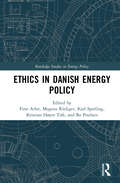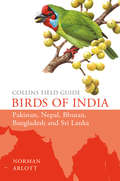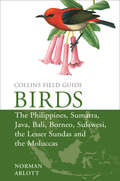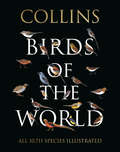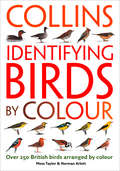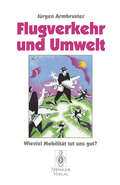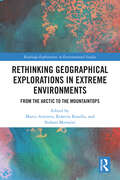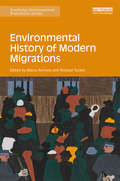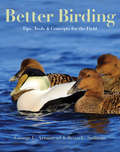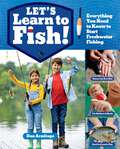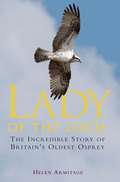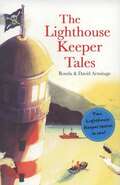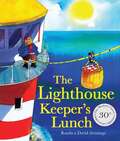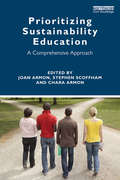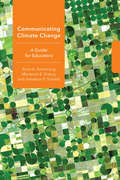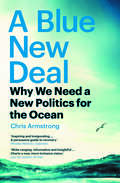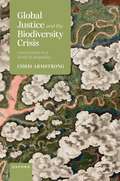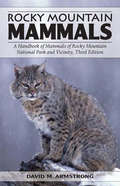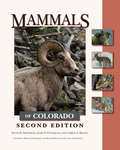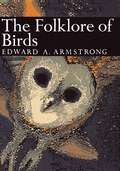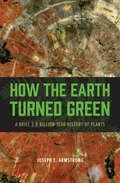- Table View
- List View
Ethics in Danish Energy Policy (Routledge Studies in Energy Policy)
by Finn Arler Mogens Rüdiger Karl Sperling Kristian Høyer Toft Bo PoulsenThis book deepens our understanding of ethical drivers in energy policy and contributes to future decision-making on transitions towards a sustainable energy system. During the latest fifty years Western energy politics have been faced with a series of ethical challenges including rapid growth, oil crises, security of supply, nuclear power and climate change. Combining philosophical, historical and planning approaches into one narrative, these dilemmas are explored using Denmark as the key case study. Drawing on contributions from several experts in the field, the ethics of energy is investigated from multiple perspectives at the individual, corporate, local and national levels, focusing on concrete decisions where different ethical considerations are weighted against each other. This comprehensive approach helps to gain a deeper understanding of the energy sector’s history and gives important input to its future layout. Drawing comparisons with European and global examples, this book will be of great interest to students and scholars of energy politics and policy, environmental ethics, climate change and sustainability transitions.
Birds of India (Collins Field Guide)
by Norman ArlottThis comprehensive new field guide is an excellent addition to the world-renowned series – the ultimate reference book for travelling birdwatchers.
Birds of the Philippines: and Sumatra, Java, Bali, Borneo, Sulawesi, the Lesser Sundas and the Moluccas (Collins Field Guides)
by Norman ArlottThis comprehensive new field guide is an excellent addition to the world-renowned series – the ultimate reference book for travelling birdwatchers.
Collins Birds of the World
by Norman Arlott Ber van Perlo Jorge R. Mata Gustavo Carrizo Aldo A. Chiappe Luis HuberFor the first time, the complete collection of the Collins Field Guides’ incredibly detailed, accurate and beautiful bird paintings has been brought together in one comprehensive volume.
Identifying Birds by Colour
by Norman Arlott Moss TaylorOptimised for devices with colour screens. A unique spotter's guide for the first-time birdwatcher.
Flugverkehr und Umwelt: Wieviel Mobilität tut uns gut?
by Jürgen ArmbrusterFür Millionen Menschen sind Flugreisen Symbol für Bewegungsfreiheit und Lebensqualität. Doch die Umweltbelastung durch diese Mobiltität ist bereits heute kaum mehr vertretbar und die Problematik wird sich mit zunehmendem Luftverkehr verschärfen. Jürgen Armbruster analysiert die Auswirkungen des Luftverkehrs auf unsere Umwelt und zeigt Perspektiven zur Lösung dieses Problems auf.
Rethinking Geographical Explorations in Extreme Environments: From the Arctic to the Mountaintops (Routledge Explorations in Environmental Studies)
by Marco Armiero Roberta Biasillo Stefano MorosiniFocusing on extreme environments, from Umberto Nobile’s expedition to the Arctic to the commercialization of Mt Everest, this volume examines global environmental margins, how they are conceived and how perceptions have changed. Mountaintops and Arctic environments are the settings of social encounters, political strategies, individual enterprises, geopolitical tensions, decolonial practises, and scientific experiments. Concentrating on mountaineering and Arctic exploration between 1880 – 1960, contributors to this volume show how environmental marginalisation has been discursively implemented and materially generated by foreign and local actors. It examines to what extent the status and identity of extreme environments has changed during modern times, moving them from periphery to the centre and discarding their marginality. The first section looks at ways in which societies have framed remoteness, through the lens of commercialization, colonialism, knowledge production and sport, while the second examines the reverse transfer, focusing on how extreme nature has influenced societies, through international network creation, political consensus and identity building. This collection enriches the historical understanding of exploration by adopting a critical approach and offering multidimensional and multi-gaze reconstructions. This book is essential reading for students and scholars interested in environmental history, geography, colonial studies and the environmental humanities.
Rethinking Geographical Explorations in Extreme Environments: From the Arctic to the Mountaintops (Routledge Explorations in Environmental Studies)
by Marco Armiero Roberta Biasillo Stefano MorosiniFocusing on extreme environments, from Umberto Nobile’s expedition to the Arctic to the commercialization of Mt Everest, this volume examines global environmental margins, how they are conceived and how perceptions have changed. Mountaintops and Arctic environments are the settings of social encounters, political strategies, individual enterprises, geopolitical tensions, decolonial practises, and scientific experiments. Concentrating on mountaineering and Arctic exploration between 1880 – 1960, contributors to this volume show how environmental marginalisation has been discursively implemented and materially generated by foreign and local actors. It examines to what extent the status and identity of extreme environments has changed during modern times, moving them from periphery to the centre and discarding their marginality. The first section looks at ways in which societies have framed remoteness, through the lens of commercialization, colonialism, knowledge production and sport, while the second examines the reverse transfer, focusing on how extreme nature has influenced societies, through international network creation, political consensus and identity building. This collection enriches the historical understanding of exploration by adopting a critical approach and offering multidimensional and multi-gaze reconstructions. This book is essential reading for students and scholars interested in environmental history, geography, colonial studies and the environmental humanities.
Environmental History of Modern Migrations (Routledge Environmental Humanities)
by Marco Armiero Richard TuckerIn the age of climate change, the possibility that dramatic environmental transformations might cause the dislocation of millions of people has become not only a matter for scientific speculation or science-fiction narratives, but the object of strategic planning and military analysis. Environmental History of Modern Migrations offers a worldwide perspective on the history of migrations throughout the nineteenth and twentieth centuries and provides an opportunity to reflect on the global ecological transformations and developments which have occurred throughout the last few centuries. With a primary focus on the environment/migration nexus, this book advocates that global environmental changes are not distinct from global social transformations. Instead, it offers a progressive method of combining environmental and social history, which manages to both encompass and transcend current approaches to environmental justice issues. This edited collection will be of great interest to students and practitioners of environmental history and migration studies, as well as those with an interest in history and sociology.
Environmental History of Modern Migrations (Routledge Environmental Humanities)
by Marco Armiero Richard TuckerIn the age of climate change, the possibility that dramatic environmental transformations might cause the dislocation of millions of people has become not only a matter for scientific speculation or science-fiction narratives, but the object of strategic planning and military analysis. Environmental History of Modern Migrations offers a worldwide perspective on the history of migrations throughout the nineteenth and twentieth centuries and provides an opportunity to reflect on the global ecological transformations and developments which have occurred throughout the last few centuries. With a primary focus on the environment/migration nexus, this book advocates that global environmental changes are not distinct from global social transformations. Instead, it offers a progressive method of combining environmental and social history, which manages to both encompass and transcend current approaches to environmental justice issues. This edited collection will be of great interest to students and practitioners of environmental history and migration studies, as well as those with an interest in history and sociology.
Better Birding: Tips, Tools, and Concepts for the Field (PDF)
by George L. Armistead Brian L. SullivanBetter Birding reveals the techniques expert birders use to identify a wide array of bird species in the field—quickly and easily. Featuring hundreds of stunning photos and composite plates throughout, this book simplifies identification by organizing the birds you see into groupings and offering strategies specifically tailored to each group. Skill building focuses not just on traditional elements such as plumage, but also on creating a context around each bird, including habitat, behavior, and taxonomy—parts so integral to every bird's identity but often glossed over by typical field guides. Critical background information is provided for each group, enabling you to approach bird identification with a wide-angle view, using your eyes, brain, and binoculars more strategically, resulting in a more organized approach to learning birds.Better Birding puts the thrill of expert bird identification within your reach.Reveals the techniques used by expert birders for quick and easy identificationSimplifies identification with strategies tailored to different groupings of birdsFeatures hundreds of photos and composite plates that illustrate the different techniquesFosters a wide-angle approach to field birdingProvides a foundation for building stronger birding skills
Let's Learn to Fish!: Everything You Need to Know to Start Freshwater Fishing
by Dan ArmitageIn this exciting introduction to freshwater fishing, fishing expert Dan Armitage teaches kids about the best bait and tackle, how to rig a rod, cast a line, and reel in their first fish. Grab a fishing rod and head out to a nearby stream or lake for a fishing adventure! In this skills-based book, kids ages 6 and up go on a fishing trip, led by author and fishing guide Dan Armitage of the Kids' Fishing Fun Program, and learn essential techniques, facts, and tips to learn how to fish and catch a big one! Step-by-step color photography shows everything kids need, the best beginner bait and tackle, key fishing skills such as rigging, casting, and reeling in fish, and tips on where to fish for crappies, bass, catfish, perch, trout, and more. Kids record fishing adventures in the log at the back of the book. The skills teach fun fishing know-how, connect kids to nature, and foster independence and self-reliance.
Lady of the Loch: The Incredible Story of Britain's Oldest Osprey (Tom Thorne Novels #211)
by Helen ArmitageDuring the last decade, the osprey has risen, phoenix-like, from the ashes - once extinct in Britain, now returned as a powerful symbol of hope. The opreys' story is a moving tale of triumph over adversity. Their slow but sure resurgence has attracted huge public interest and support; that of one bird in particular, Lady, at 25, Britain's oldest breeding osprey, has tugged at the world's heartstrings.For the past twenty years, Lady has made the 3000-mile journey from Africa back to Scotland, her nest and her mate. In March 2010, she produced an egg for a record-breaking 20th year; despite her weakened state throughout that summer, and with the stalwart assistance of her youthful mate, the chicks fledged successfully. But how many more times can Lady defy the odds; will the spring see her return, as, happily, it will so many other ospreys?
The Lighthouse Keeper Tales (The\lighthouse Keeper Ser.)
by Ronda Armitage David ArmitageWill Mr Grinling ever learn to surf? And will the Grinlings escape their pirate captors? Find out in these two charming Lighthouse Keeper tales, now in one fantastic B-format bind-up.
The Lighthouse Keeper's Lunch (The\lighthouse Keeper Ser.)
by Ronda Armitage David ArmitageAvailable for the first time as an ebook, THE LIGHTHOUSE KEEPER'S LUNCH is a modern classic, loved by children everywhere. Every day the lighthouse keeper tucks into a delicious lunch. But he isn't the only one who enjoys the tasty food. What will stop the greedy gulls from stealing the lighthouse keeper's lunch?
Prioritizing Sustainability Education: A Comprehensive Approach
by Joan Armon Stephen Scoffham Chara ArmonPrioritizing Sustainability Education presents theory-to-practice essays and case studies by educators from six countries who elucidate dynamic approaches to sustainability education. Too often, students graduate with exploitative, consumer-driven orientations toward ecosystems and are unprepared to confront the urgent challenges presented by environmental degradation. Educators are prioritizing sustainability-oriented courses and programs that cultivate students’ knowledge, skills, and values and contextualize them within relational connections to local and global ecosystems. Little has yet been written, however, about the comprehensive sustainability education that educators are currently designing and implementing, often across or at the edges of disciplinary boundaries. The approaches described in this book expand beyond conventional emphases on developing students’ attitudes, knowledge, and behaviors by thinking and talking about ecosystems to additionally engaging students with ecosystems in sensory, affective, psychological, and cognitive dimensions, as well as imaginative, spiritual, or existential dimensions that guide environmental care and regeneration. This book supports educators and graduate and upper-level undergraduate students in the humanities, social sciences, environmental studies, environmental sciences, and professional programs in considering how to reorient their fields toward relational sustainability perspectives and practices.
Prioritizing Sustainability Education: A Comprehensive Approach
by Joan Armon Stephen Scoffham Chara ArmonPrioritizing Sustainability Education presents theory-to-practice essays and case studies by educators from six countries who elucidate dynamic approaches to sustainability education. Too often, students graduate with exploitative, consumer-driven orientations toward ecosystems and are unprepared to confront the urgent challenges presented by environmental degradation. Educators are prioritizing sustainability-oriented courses and programs that cultivate students’ knowledge, skills, and values and contextualize them within relational connections to local and global ecosystems. Little has yet been written, however, about the comprehensive sustainability education that educators are currently designing and implementing, often across or at the edges of disciplinary boundaries. The approaches described in this book expand beyond conventional emphases on developing students’ attitudes, knowledge, and behaviors by thinking and talking about ecosystems to additionally engaging students with ecosystems in sensory, affective, psychological, and cognitive dimensions, as well as imaginative, spiritual, or existential dimensions that guide environmental care and regeneration. This book supports educators and graduate and upper-level undergraduate students in the humanities, social sciences, environmental studies, environmental sciences, and professional programs in considering how to reorient their fields toward relational sustainability perspectives and practices.
Communicating Climate Change: A Guide for Educators (Cornell Series in Environmental Education)
by Anne K. Armstrong Marianne E. Krasny Jonathon P. SchuldtEnvironmental educators face a formidable challenge when they approach climate change due to the complexity of the science and of the political and cultural contexts in which people live. There is a clear consensus among climate scientists that climate change is already occurring as a result of human activities, but high levels of climate change awareness and growing levels of concern have not translated into meaningful action. Communicating Climate Change provides environmental educators with an understanding of how their audiences engage with climate change information as well as with concrete, empirically tested communication tools they can use to enhance their climate change program.Starting with the basics of climate science and climate change public opinion, Armstrong, Krasny, and Schuldt synthesize research from environmental psychology and climate change communication, weaving in examples of environmental education applications throughout this practical book. Each chapter covers a separate topic, from how environmental psychology explains the complex ways in which people interact with climate change information to communication strategies with a focus on framing, metaphors, and messengers. This broad set of topics will aid educators in formulating program language for their classrooms at all levels. Communicating Climate Change uses fictional vignettes of climate change education programs and true stories from climate change educators working in the field to illustrate the possibilities of applying research to practice. Armstrong et al, ably demonstrate that environmental education is an important player in fostering positive climate change dialogue and subsequent climate change action.Thanks to generous funding from Cornell University, the ebook editions of this book are available as Open Access from Cornell Open (cornellopen.org) and other Open Access repositories.
A Blue New Deal: Why We Need a New Politics for the Ocean
by Chris ArmstrongAn urgent account of the state of our oceans today—and what we must do to protect themThe ocean sustains life on our planet, from absorbing carbon to regulating temperatures, and, as we exhaust the resources to be found on land, it is becoming central to the global market. But today we are facing two urgent challenges at sea: massive environmental destruction, and spiraling inequality in the ocean economy.Chris Armstrong reveals how existing governing institutions are failing to respond to the most pressing problems of our time, arguing that we must do better. Armstrong examines these crises—from the fate of people whose lands will be submerged by sea level rise, to the exploitation of people working in fishing, to the rights of marine animals—and makes the case for a powerful World Ocean Authority capable of tackling them. A Blue New Deal presents a radical manifesto for putting equality, democracy, and sustainability at the heart of ocean politics.
Global Justice and the Biodiversity Crisis: Conservation in a World of Inequality
by Chris ArmstrongThe world is in the midst of a biodiversity crisis, which existing conservation policies have failed to arrest. Policymakers, academics, and the general public are coming to recognise that much more ambitious conservation policies are in order. But biodiversity conservation raises major issues of global justice - even if the connection between conservation and global justice is too seldom made. The lion's share of conservation funding is spent in the global North, despite the fact that most biodiversity exists in the global South, and local people can often scarcely afford to make sacrifices in the interests of biodiversity conservation. Many responses to the biodiversity crisis threaten to exacerbate existing global injustices, to lock people into poverty, and to exploit the world's poor. At the extreme, policies aimed at protecting biodiversity have also been associated with exclusion, dispossession, and violence. The challenge this book grapples with is how biodiversity might be conserved without producing global injustice. It distinguishes policies which are likely to exacerbate global injustice, and policies which promise to reduce them. The struggle to formulate and implement just conservation policies is vital to our planet's future.
Global Justice and the Biodiversity Crisis: Conservation in a World of Inequality
by Chris ArmstrongThe world is in the midst of a biodiversity crisis, which existing conservation policies have failed to arrest. Policymakers, academics, and the general public are coming to recognise that much more ambitious conservation policies are in order. But biodiversity conservation raises major issues of global justice - even if the connection between conservation and global justice is too seldom made. The lion's share of conservation funding is spent in the global North, despite the fact that most biodiversity exists in the global South, and local people can often scarcely afford to make sacrifices in the interests of biodiversity conservation. Many responses to the biodiversity crisis threaten to exacerbate existing global injustices, to lock people into poverty, and to exploit the world's poor. At the extreme, policies aimed at protecting biodiversity have also been associated with exclusion, dispossession, and violence. The challenge this book grapples with is how biodiversity might be conserved without producing global injustice. It distinguishes policies which are likely to exacerbate global injustice, and policies which promise to reduce them. The struggle to formulate and implement just conservation policies is vital to our planet's future.
Rocky Mountain Mammals: A Handbook of Mammals of Rocky Mountain National Park and Vicinity, Third Edition
by David M. ArmstrongRevised, updated, and with more than 80 new color photographs, Rocky Mountain Mammals, Third Edition is a nontechnical guide to the mammals of the Southern Rocky Mountains and their foothills, with special emphasis on Rocky Mountain National Park and vicinity. Designed for quick reference and enjoyable reading, Rocky Mountain Mammals offers what most field guides don't - a wealth of fascinating information about each species. In seventy-two species accounts, David M. Armstrong describes each animal and its signs, habits, habitat, and natural history, noting times when seasonal events such as elk sparring occur. Introductory materials and appendices offer rich context and wildlife-watching support, including a checklist with page numbers for quick field reference, an identification key, a glossary, derivations of scientific names, and advice on how, when, and where to watch mammals. Armstrong introduces mammalian evolution, anatomy, and distribution and offers perspective on how the local fauna fits into its geographical setting and into past and potential future faunas of the region. This lavishly illustrated new edition will delight those who live in and visit the high country and foothills of the Southern Rockies and want to identify mammals and learn about their lives. Published in association with the Rocky Mountain Nature Association.
Mammals of Colorado, Second Edition
by David M. Armstrong James P. Fitzgerald Carron A. MeaneyThoroughly revised and updated, Mammals of Colorado, Second Edition is a comprehensive reference on the nine orders and 128 species of Colorado's recent native fauna, detailing each species' description, habitat, distribution, population ecology, diet and foraging, predators and parasites, behavior, reproduction and development, and population status. An introductory chapter on Colorado's environments, a discussion of the development of the fauna over geologic time, and a brief history of human knowledge of Coloradan mammals provide ecological and evolutionary context. The most recent records of the state's diverse species, rich illustrations (including detailed maps, skull drawings, and photographs), and an extensive bibliography make this book a must-have reference. Amateur and professional naturalists, students, vertebrate biologists, and ecologists as well as those involved in conservation and wildlife management in Colorado will find value in this comprehensive volume. Co-published with the Denver Museum of Nature & Science
The Folklore of Birds: An Enquiry Into The Origin & Distribution Of Some Magico-religious Traditions (Collins New Naturalist Library #39)
by Edward A. ArmstrongTracing the magico-religious beliefs surrounding birds as far back in time as is possible, to the cultures in which these beliefs arose. This edition is exclusive to newnaturalists.com
How the Earth Turned Green: A Brief 3.8-Billion-Year History of Plants
by Joseph E. ArmstrongOn this blue planet, long before pterodactyls took to the skies and tyrannosaurs prowled the continents, tiny green organisms populated the ancient oceans. Fossil and phylogenetic evidence suggests that chlorophyll, the green pigment responsible for coloring these organisms, has been in existence for some 85% of Earth’s long history—that is, for roughly 3.5 billion years. In How the Earth Turned Green, Joseph E. Armstrong traces the history of these verdant organisms, which many would call plants, from their ancient beginnings to the diversity of green life that inhabits the Earth today. Using an evolutionary framework, How the Earth Turned Green addresses questions such as: Should all green organisms be considered plants? Why do these organisms look the way they do? How are they related to one another and to other chlorophyll-free organisms? How do they reproduce? How have they changed and diversified over time? And how has the presence of green organisms changed the Earth’s ecosystems? More engaging than a traditional textbook and displaying an astonishing breadth, How the Earth Turned Green will both delight and enlighten embryonic botanists and any student interested in the evolutionary history of plants.
